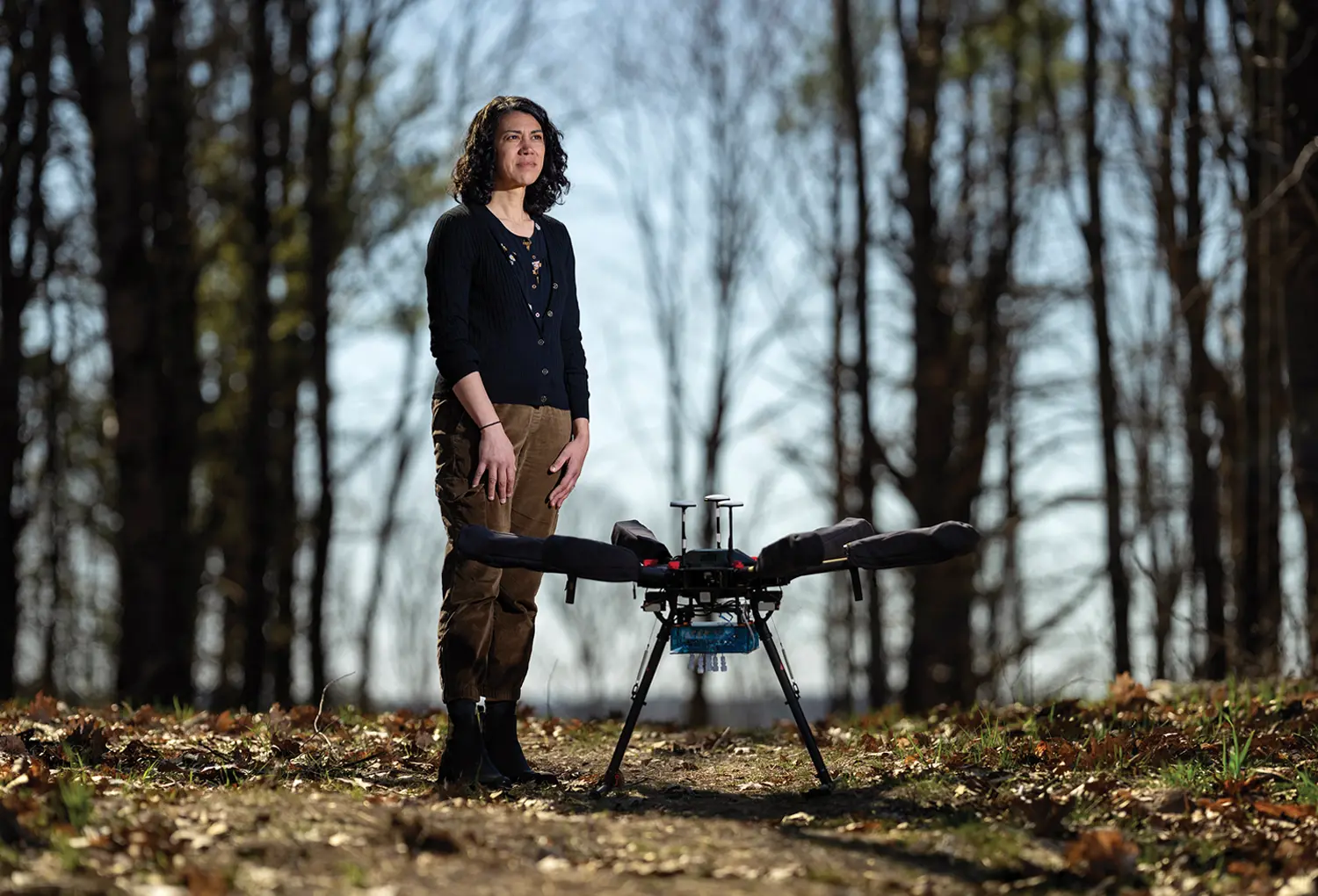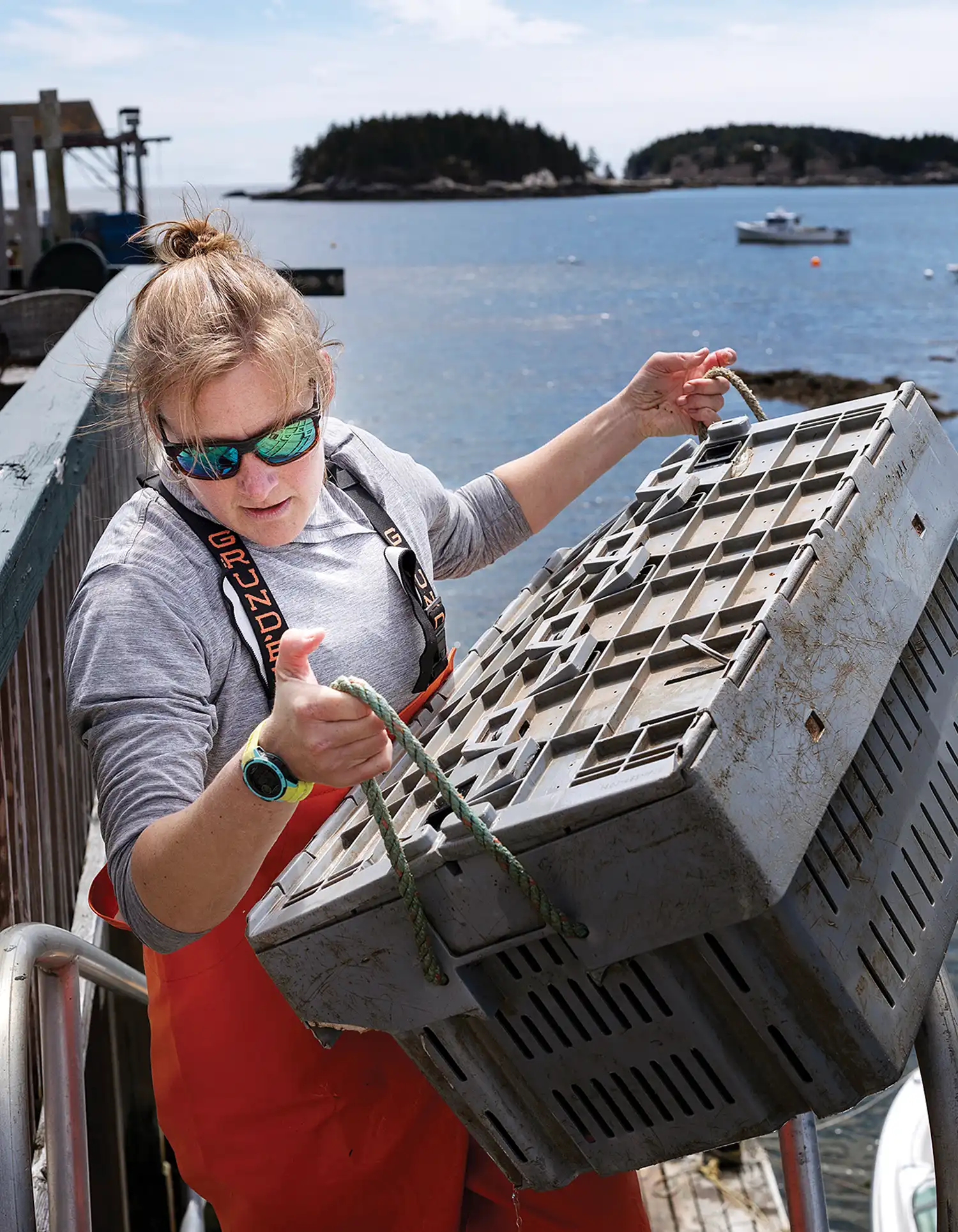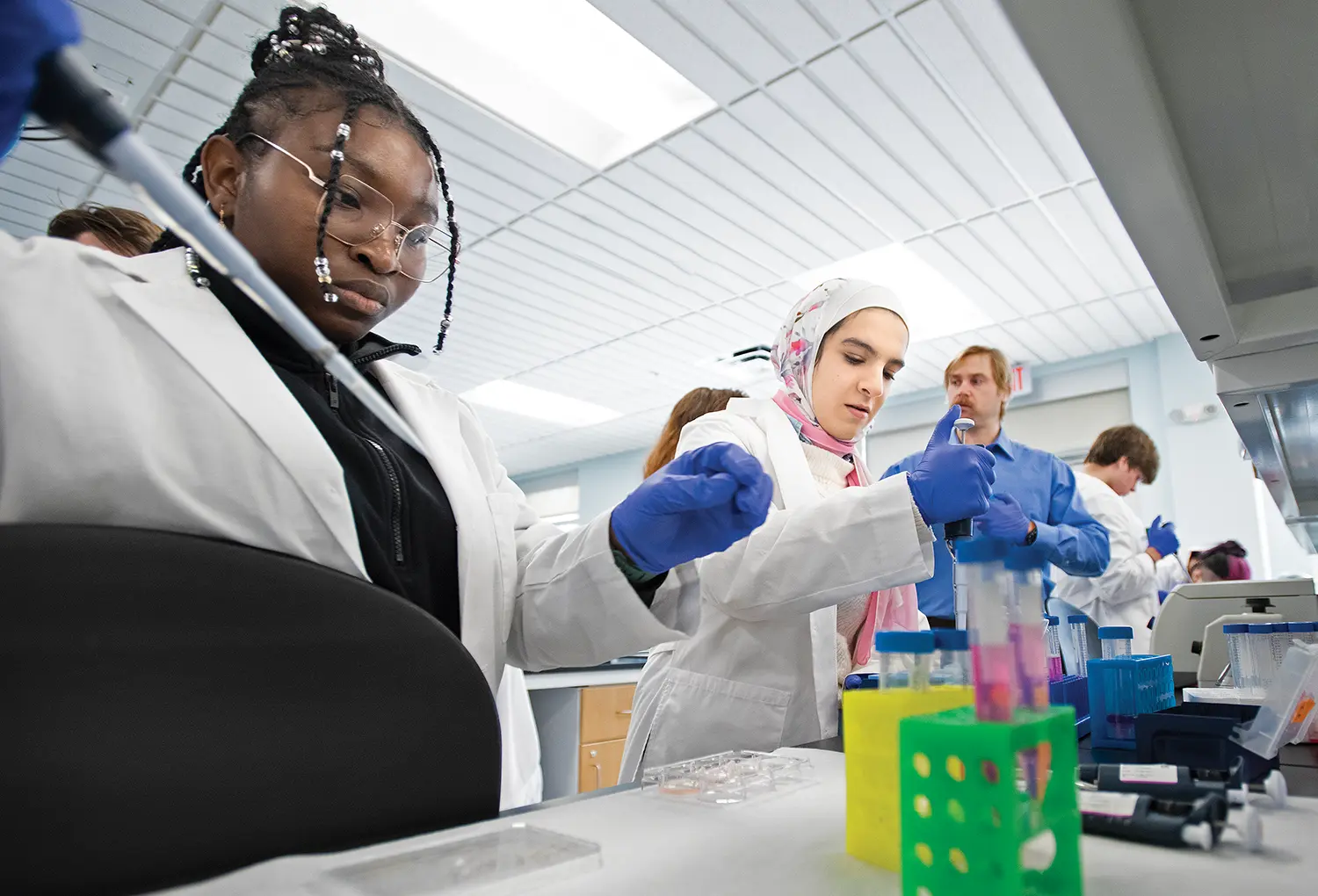
Building on Traditional Strengths in the Sciences, Colby Plans for ‘New Ways of Knowing’
As the world changes, Colby sciences are changing with it
Illustration by Samuel Onche ’22
Photographs by Ashley L. Conti, Kevin Bennett
With its planned investments in programs and facilities, Colby hopes to expand opportunities for students, faculty, and the public at large by creating unique applied engineering and public health programming that emphasizes the environment, biomedicine, and issues that impact Maine residents, including such examples as an aging population, water quality, and the opioid epidemic. These focus areas would build on the strengths Colby has developed over the past half-century of research and community outreach and be amplified by a strategic expansion of Colby’s computational infrastructure, a growing network of partners, and a collective commitment to improve both global communities and the lives of Mainers.
“We have a great program in the sciences right now, but is there any field changing faster?” he asked. “We are going to create a science program that is not only right for what we need now but also for what we need in the future. We’re going to hold onto our core values, beliefs, and traditions in the liberal arts while integrating new ways of knowing, new ways of exploring, and new ways of discovery and learning.”
The Colby vision seeks to develop the talents of a diverse pool of undergraduates by expanding the College’s portfolio of partnerships with other academic institutions and independent research laboratories, positioning students to be change-makers of the future.
Faculty members have been working for more than a year on programming for a new integrated and collaborative science program. Planning teams have visited academic and commercial labs, interviewed leaders in engineering instruction and research, and critically evaluated the strengths and opportunities of our current programs. These efforts now provide the foundation for Colby’s science planning process.
The new programs would connect to immediate community needs while developing new areas of research and opportunities often seen only at major research institutions. To accommodate these programs, the College has begun planning for a new science center complete with wet labs, high-performance computational capacities, and purpose-built spaces designed to promote curricular integration and collaboration that are foundational for Colby science outcomes today and in decades to come.
The sciences are changing
“We need to take the programs that we have in fundamental science and enrich them by integrating them with applied science fields so that the two of those come together,” Greene said. “That’s where the magic is happening right now in all kinds of discoveries.”
Current faculty emphasize that the sciences are becoming interdisciplinary, not only with collaborations among scientific disciplines but also among the sciences and other areas of study.
“There are synergies,” said Associate Professor of Chemistry Karena McKinney. “You just have to figure out how to empower everybody in those interactions. Help build the bridges, and not just the ones that seem obvious.”
McVey Center for Computational and Data Sciences
The McVey Center will serve as both a scholarly and teaching resource, driving discovery and empowering students to build skills specific to the needs of their field. The McVey Center will join Colby’s sector-leading Davis Institute for Artificial Intelligence to provide academic opportunities unparalleled in a liberal arts setting.
The new center will provide students with the computational and data science knowledge and practical expertise that employers in almost every sector are demanding while offering faculty significant resources and support to integrate these powerful tools into their courses and research.

Associate Professor of Chemistry Karena McKinney is using a National Science Foundation grant to study emissions from trees, also known as biogenic volatile organic compounds, and their impact on climate change.

Assistant Professor of Environmental Studies Cait Cleaver ’06 carries a crate of juvenile scallop spat bags to process at the Maine Oyster Company in Phippsburg, Maine. As part of an effort to develop aquaculture to adapt to the changing climate, Cleaver and her students work at four locations along the coast in partnership with scallop fishermen, scallop farmers, the Maine Center for Coastal Fisheries, and the Hurricane Island Center for Science and Leadership.
Advanced computation is a central new technology supporting discovery and analysis. Computation allows researchers to examine enormous data sets and create models that simulate the processes they’re studying in broader contexts, and, as a result, derive real-world implications over wider and more complex scales than ever before.
“Computation is becoming integral to the ways that sciences, and also increasingly other disciplines, do their work,” said Associate Professor of Biology Suegene Noh. “We want to lower the barriers to using advanced computation so that faculty and students can do their best work. This includes creating new courses that provide students with a solid computational foundation critical to many future careers.”
Impact on Maine
“Maine is a small state with research organizations that are making big science discoveries every day. Colby’s research partners benefit from the energy and talents of our students, and our students gain invaluable experience working with exceptional research mentors,” said Miselis Professor of Chemistry D. Whitney King.
Expanding research collaborations and designing project-based courses will immerse students in solution-focused work that addresses global challenges and has a direct impact on communities in Maine.
Mitigating shoreline erosion, providing clean drinking water, using bioinformatics to study genetic diseases, and continuing to evolve the Maine Drug Policy Lab at Colby College—a collaborative, multi-stakeholder effort aimed at studying drug usage and policy reform—are some of many new ideas that have emerged from the science planning process.
“There is a real need to be doing science that matters to our community and minimizes environmental loss caused by the changing climate,” said Assistant Professor of Environmental Studies Cait Cleaver ’06.
Strong K-12 education is the foundation of a vibrant Maine economy. The science plan includes science outreach spaces, expanded collaboration with local teachers, and new public programming for all ages.
A science center for the future
“The facility will be a vessel to hold innovative and forward-looking programs, not a building that is about what we’re doing currently, but what we need to be doing over the next 25 and 50 years,” Greene said.

“We want the new building to enable us to teach in new and different modalities,” said Assistant Professor of Chemistry Greg Drozd, “to give us a chance to update our curricula and enhance active learning to the benefit of our students.”
New facilities and programs will also require additional personnel, including staff to support faculty innovation. Expanding the sciences will also allow Colby to take on more postdoctoral researchers, who, according to Noh, “are really valuable for infusing new ideas and new technologies into academia” because they are professionally situated at the leading edge of their fields.
New spaces could open doors to postbaccalaureate technicians as well, who, as young professionals, can receive career-building experience while supporting Colby’s research and outreach initiatives.
Liberal arts remain at the core
Along these lines, many professors share a goal of co-teaching in the future, of designing courses or projects that teach students to apply their skills in ways that draw upon disciplines outside their majors and simultaneously enable faculty to learn from one another.
Faculty laud the liberal arts for their ability to transform undergraduates into researchers capable of making meaningful contributions to science. “They get way more contact time with faculty, more hands-on time doing very challenging things that normally would be reserved for graduate students at most other institutions,” echoed Associate Professor of Geology Bess Koffman.
Such deep involvement teaches students to take ownership of their research while providing opportunities to learn experientially through fieldwork and outreach that fosters a work ethic grounded in curiosity and collaboration. That is already happening at Colby—and the community is excited to amplify these outcomes in the future.
“If we want to be the best, if we really want Colby to be the most extraordinary liberal arts college, then we will lead in the sciences,” Greene said. “We will be more forward-leaning, more innovative, more risk-taking, and we will put Colby at the forefront of all that work—and do it in a way that helps the whole state of Maine and helps all of our students go on to do extraordinary things.”